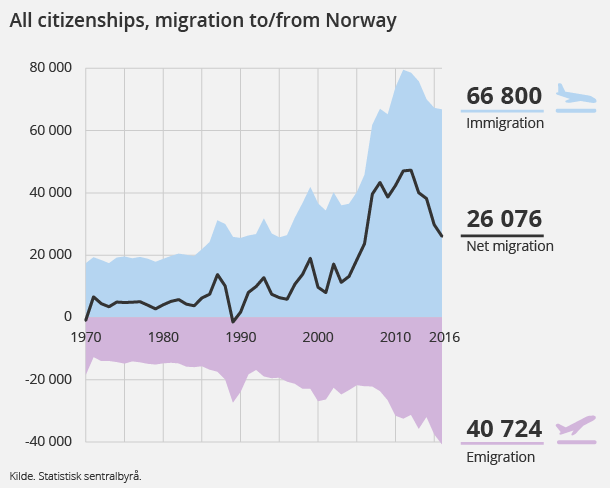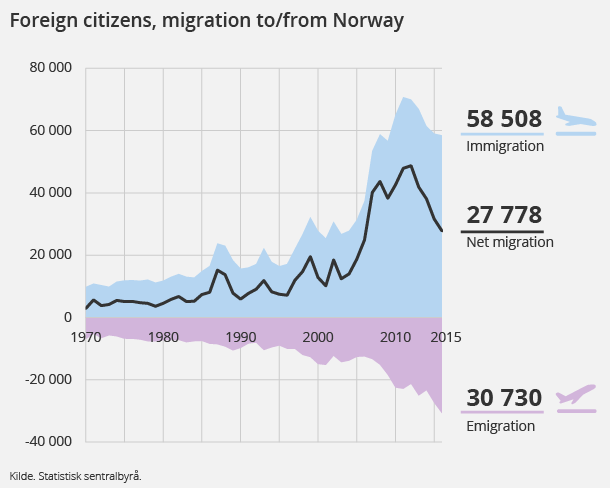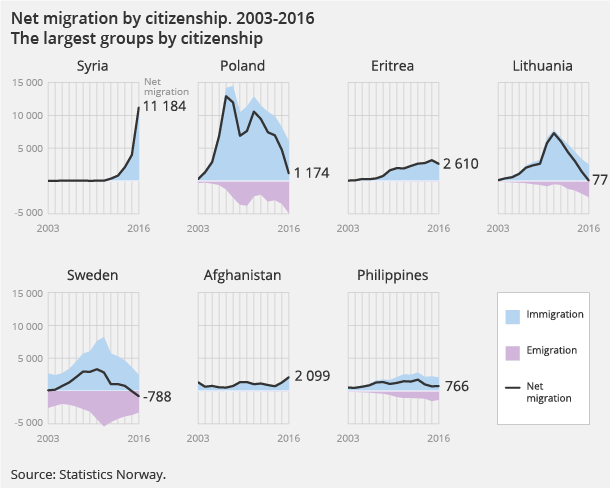Lowest net immigration in ten years
Published:
Net immigration to Norway in 2016 was 3 700 lower than the previous year due to the particularly high level of emigration, according to new figures from the statistics Migrations. More arriving from Asia, especially Syria, and fewer arriving from Europe.
- Full set of figures
- Migrations
- Series archive
- Migrations (archive)
A total of 66 800 persons immigrated to Norway in 2016; 500 fewer than the previous year, while just over 40 700 people emigrated; 3 300 more than in 2015. This resulted in a net immigration of 26 100, which is the lowest figure since 2006. Since the peak year of 2012, net immigration has fallen by 21 300.
The trend of falling immigration continues. On average, 2 500 fewer people have immigrated to Norway every year since the record year of 2011 when 79 500 immigrated. Since the registrations began in 1951, emigration from Norway peaked in 2016. Emigration has been extensive since 2010, with a minimum of 31 000 emigrations annually.
Strong increase in net immigration from Asia, strong fall from Europe
The net immigration of Asian citizens increased by 8 700, while the number of European citizens (excluding Norwegian) decreased by 10 600. The Asian citizens’ share of net immigration rose to 64 per cent; 45 percentage points more than the year before, while the Europeans’ share fell by 32 percentage points, down to 14 per cent.
The net migration of Asian citizens almost doubled from 9 000 in 2015 to 17 700 in 2016. The growth is mainly due to increased immigration from war-torn Syria. In 2015, 4 000 more Syrians arrived in Norway than left, and this increased to 11 200 in 2016. This means they accounted for 43 per cent of all net migration to Norway. On the other side, they made up 63 per cent of net migration from Asia. Citizens from Lebanon, Afghanistan, Thailand and India also made large contributions to the net immigration from Asia.
In 2016, the total net immigration from Europe was 4 000, compared with 14 600 the previous year. The fall is a result of a drop of 7 100 in immigration and a rise of 3 500 in emigration. Net immigration has seen a particular decline among Rumanian, Lithuanian and Swedish citizens, with Polish citizens making up the largest group.
Fewer from Poland, Lithuania and Sweden
Over the past four years, the annual net immigration of Swedish, Lithuanian and Polish citizens, who often immigrate for work, fell by 16 100. In 2016, the groups had a total of just under 500 net immigrations, and made up only 2 per cent of net immigration to Norway; a share that has fallen from 44 per cent in 2011. This is related to the changes in the economic situation in Norway and abroad, where the demand for a foreign workforce is reduced (for info on the Norwegian economy, see The Economic Survey 1-2017)
Polish citizens, who are the largest immigrant group in Norway, are still experiencing a positive net immigration to Norway, although the number has fallen considerably since 2011. Net immigration of Polish citizens was 10 600 in 2011, compared to just 1 200 in 2016. The decline of 3 600 from 2015 to 2016 is the largest since the downturn began in 2012.
The net migration of Swedish citizens has also fallen since 2011, and in 2015 it changed to a net emigration, when around 20 more left than came. In 2016, the net emigration increased to just under 800. This happened because 1 100 fewer immigrated, and 400 fewer emigrated.
Compared with the years 2007-2014, when Lithuanian citizens had an annual average net immigration of 4 200, the figure for 2016 is marginally positive, with only 100 more arriving than leaving. This was 1 300 and 3 000 fewer respectively than in 2015 and in 2014.
Contact
-
Adrian Haugen Ordemann
-
Statistics Norway's Information Centre



